

Compact Muon Solenoid
LHC, CERN
| CMS-EXO-18-008 ; CERN-EP-2018-208 | ||
| Search for an $L_{\mu}-L_{\tau}$ gauge boson using $\mathrm{Z}\to4\mu$ events in proton-proton collisions at $\sqrt{s} = $ 13 TeV | ||
| CMS Collaboration | ||
| 11 August 2018 | ||
| Phys. Lett. B 792 (2019) 345 | ||
| Abstract: A search for a narrow Z' gauge boson with a mass between 5 and 70 GeV resulting from an $L_{\mu}-L_{\tau}$ U(1) local gauge symmetry is reported. Theories that predict such a particle have been proposed as an explanation of various experimental discrepancies, including the lack of a dark matter signal in direct-detection experiments, tension in the measurement of the anomalous magnetic moment of the muon, and reports of possible lepton flavor universality violation in B meson decays. A data sample of proton-proton collisions at a center-of-mass energy of 13 TeV is used, corresponding to an integrated luminosity of 77.3 fb$^{-1}$ recorded in 2016 and 2017 by the CMS detector at the LHC. Events containing four muons with an invariant mass near the standard model Z boson mass are analyzed, and the selection is further optimized to be sensitive to the events that may contain $\mathrm{Z} \to \mathrm{Z'}\mu\mu\to4\mu$ decays. The event yields are consistent with the standard model predictions. Upper limits of $ 10^{-8} $-$ 10^{-7} $ at 95% confidence level are set on the product of branching fractions $\mathcal{B}(\mathrm{Z} \to \mathrm{Z'} \mu \mu) \mathcal{B}(\mathrm{Z'} \to\mu \mu)$, depending on the Z' mass, which excludes a Z' boson coupling strength to muons above 0.004-0.3. These are the first dedicated limits on $L_{\mu}-L_{\tau}$ models at the LHC and result in a significant increase in the excluded model parameter space. The results of this search may also be used to constrain the coupling strength of any light Z' gauge boson to muons. | ||
| Links: e-print arXiv:1808.03684 [hep-ex] (PDF) ; CDS record ; inSPIRE record ; CADI line (restricted) ; | ||
| Figures | |

png pdf |
Figure 1:
Leading order Feynman diagrams for the signal process (left) and the dominant background process (right), where in each diagram the four-muon final state originates from annihilation. |
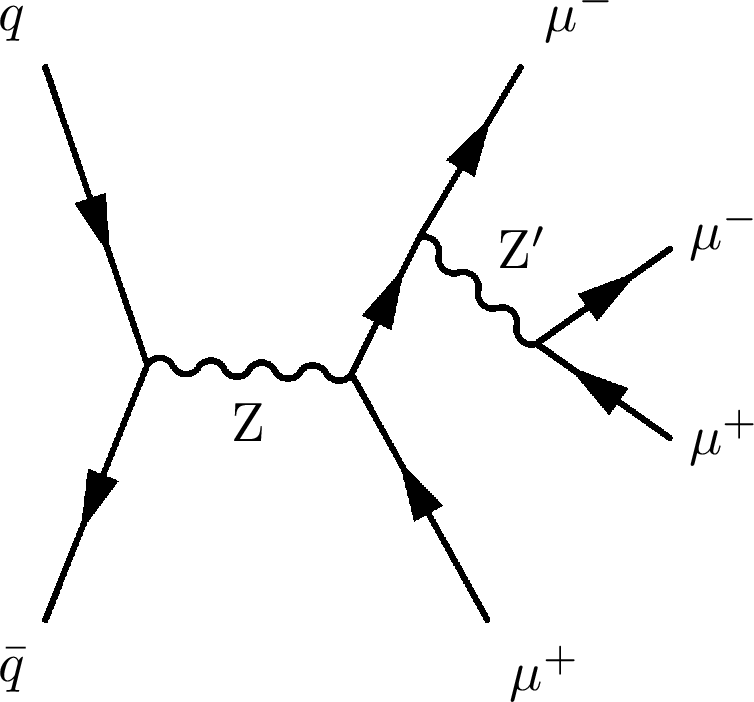
png pdf |
Figure 1-a:
Leading order Feynman diagram for the signal process, where the four-muon final state originates from annihilation.. |
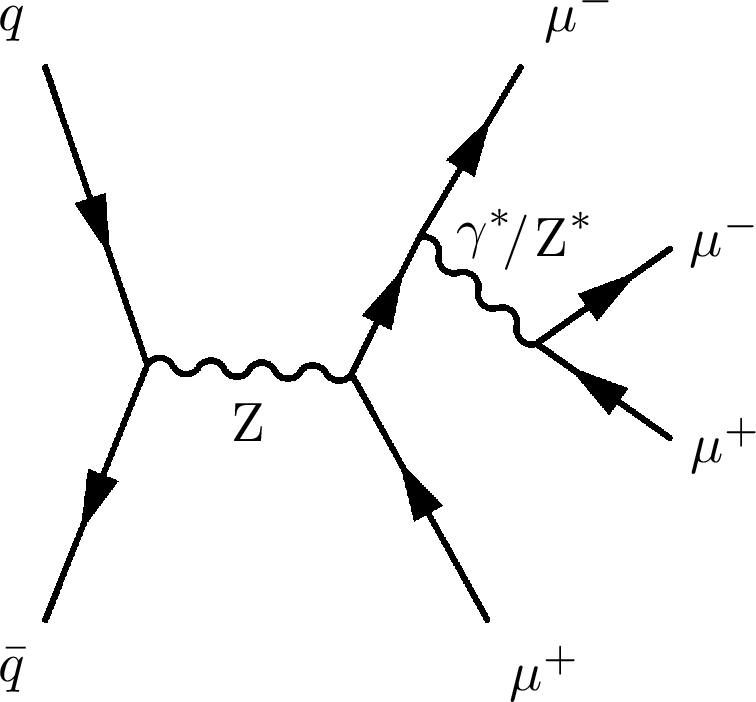
png pdf |
Figure 1-b:
Leading order Feynman diagram for the dominant background process, where the four-muon final state originates from annihilation.. |

png pdf |
Figure 2:
Leading order Feynman diagrams for the subdominant quark-initiated (left) and gluon-initiated (right) background processes, where in each diagram the four-muon final state originates from conversion. |
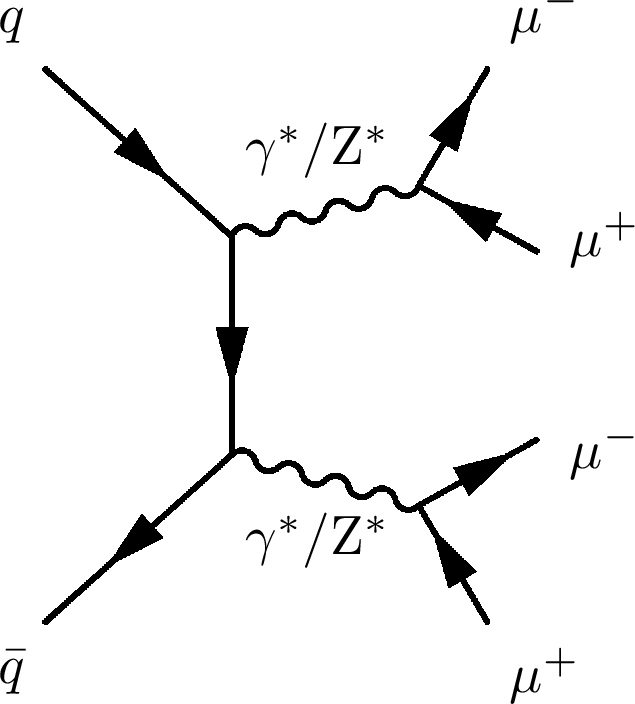
png pdf |
Figure 2-a:
Leading order Feynman diagram for the subdominant quark-initiated background processes, where the four-muon final state originates from conversion. |
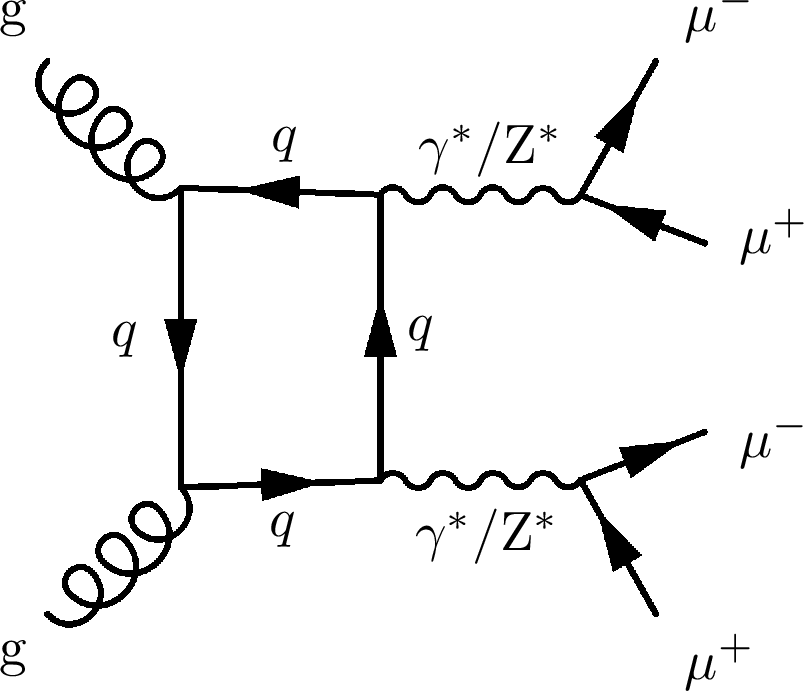
png pdf |
Figure 2-b:
Leading order Feynman diagram for the subdominant gluon-initiated background processes, where the four-muon final state originates from conversion. |
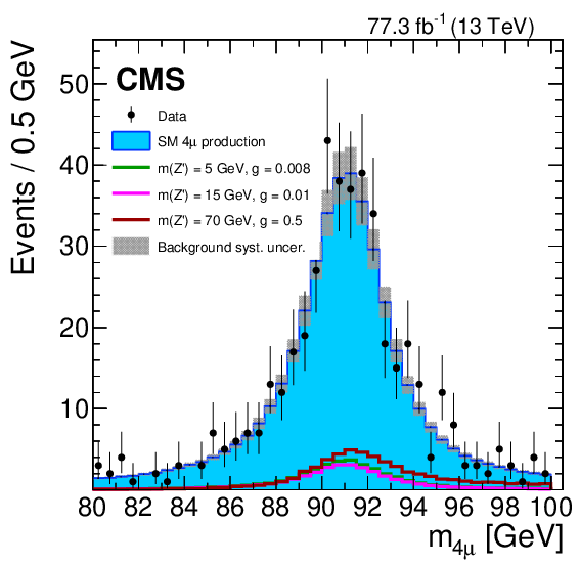
png pdf |
Figure 3:
Distribution of the reconstructed four-muon invariant mass $ {m_{4 {\mu}}} $ in the full mass range and a comparison to the predicted $ {{\mathrm {q}} {\overline {\mathrm {q}}}} / {\mathrm {g}} {\mathrm {g}} \to 4 {{\mu}}$ background. The blue histogram represents the expected SM 4$ {{\mu}}$ background distribution and the gray band shows the systematic uncertainty in its prediction. For illustration, three Z' signal hypotheses with different masses and coupling strengths are shown by colored lines. |
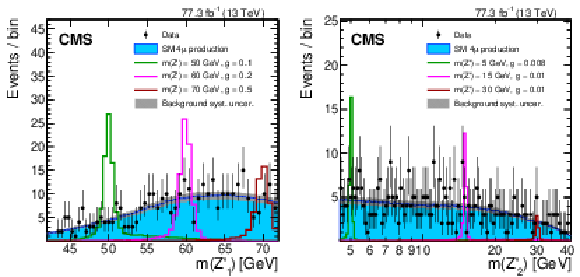
png pdf |
Figure 4:
Distributions of the reconstructed $m({\mathrm {Z}'}_1)$ and $m({\mathrm {Z}'}_2)$ observables and a comparison to the predicted $ {{\mathrm {q}} {\overline {\mathrm {q}}}} / {\mathrm {g}} {\mathrm {g}} \to 4 {{\mu}}$ background. The variable bin width has been chosen according to the expected mass resolution. The blue histogram represents the expected SM 4$ {{\mu}}$ background distributions and the gray band shows the systematic uncertainty in its prediction. For illustration, three Z' signal hypotheses with different masses and coupling strengths are also shown by colored lines. |

png pdf |
Figure 4-a:
Distribution of the reconstructed $m({\mathrm {Z}'}_1)$ observable and a comparison to the predicted $ {{\mathrm {q}} {\overline {\mathrm {q}}}} / {\mathrm {g}} {\mathrm {g}} \to 4 {{\mu}}$ background. The variable bin width has been chosen according to the expected mass resolution. The blue histogram represents the expected SM 4$ {{\mu}}$ background distributions and the gray band shows the systematic uncertainty in its prediction. For illustration, three Z' signal hypotheses with different masses and coupling strengths are also shown by colored lines. |
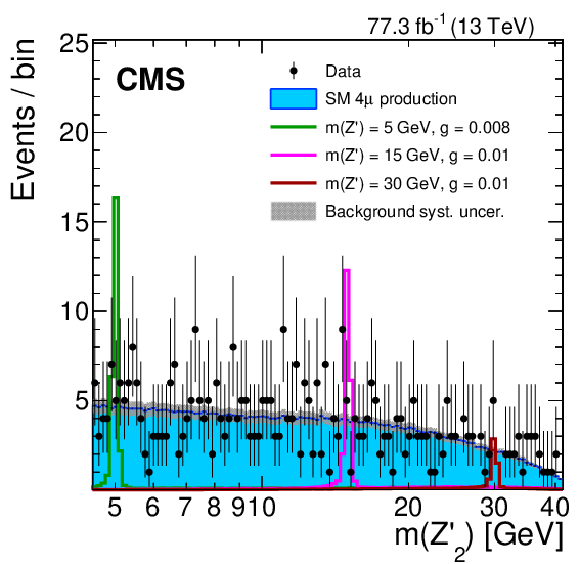
png pdf |
Figure 4-b:
Distribution of the reconstructed $m({\mathrm {Z}'}_2)$ observable and a comparison to the predicted $ {{\mathrm {q}} {\overline {\mathrm {q}}}} / {\mathrm {g}} {\mathrm {g}} \to 4 {{\mu}}$ background. The variable bin width has been chosen according to the expected mass resolution. The blue histogram represents the expected SM 4$ {{\mu}}$ background distributions and the gray band shows the systematic uncertainty in its prediction. For illustration, three Z' signal hypotheses with different masses and coupling strengths are also shown by colored lines. |
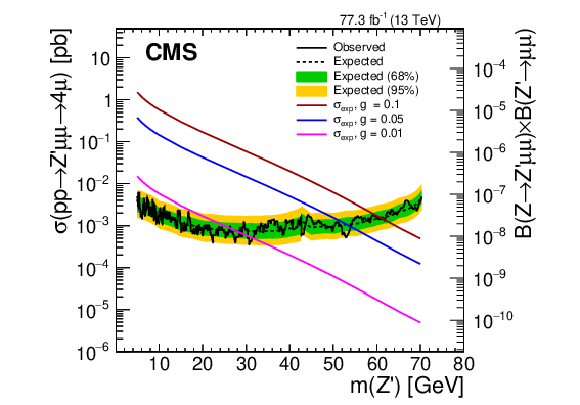
png pdf |
Figure 5:
Expected and observed 95% CL limits on the product of the $ {\mathrm {Z}'}\mu \mu $ production cross section and branching fraction (left y-axis) and $\mathcal {B}({\mathrm {Z}}\to {\mathrm {Z}'} {{\mu}} {{\mu}}) \mathcal {B}({\mathrm {Z}'}\to {{\mu}} {{\mu}})$ (right y-axis). The dashed black curve is the expected upper limit, with one and two standard-deviation bands shown in green and yellow, respectively. The solid black curve is the observed upper limit. The colored lines show the predicted cross section times branching fraction (left y-axis) and $\mathcal {B}({\mathrm {Z}}\to {\mathrm {Z}'} {{\mu}} {{\mu}}) \mathcal {B}({\mathrm {Z}'}\to {{\mu}} {{\mu}})$ (right y-axis) as a function of $m({\mathrm {Z}'})$ for three different coupling strengths, chosen for illustration. The $\mathcal {B}({\mathrm {Z}'}\to {{\mu}} {{\mu}})$ is taken to be $1/3$ to derive the theoretical predictions. |
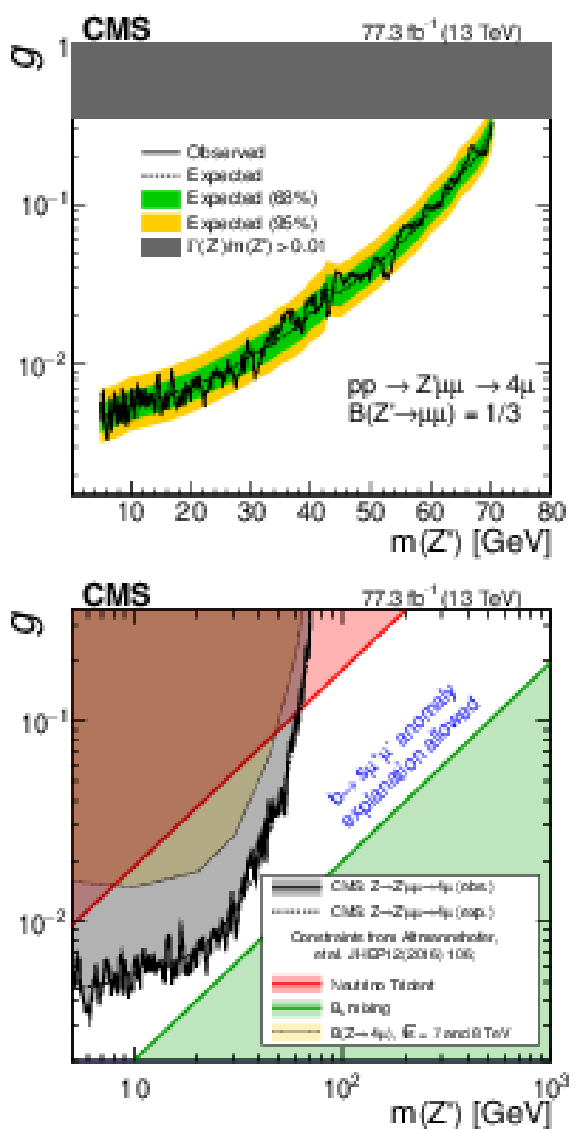
png pdf |
Figure 6:
Top: Expected and observed 95% CL limits on the gauge coupling strength $g$ as a function of $m({\mathrm {Z}'})$. The dashed black curve is the expected upper limit, with one and two standard-deviation bands shown in green and yellow, respectively. The solid black curve is the observed upper limit. The $\mathcal {B}({\mathrm {Z}}^{\prime} \to {{\mu}} {{\mu}}) = $ 1/3 is used to derive the upper limits. The hatched area shows the region where the narrow width approximation is no longer valid. Bottom: comparison with other experiments sensitive to the same parameter space, with shaded regions being excluded as described in the text. These three constraints are adapted from Ref. [13]. |

png pdf |
Figure 6-a:
Expected and observed 95% CL limits on the gauge coupling strength $g$ as a function of $m({\mathrm {Z}'})$. The dashed black curve is the expected upper limit, with one and two standard-deviation bands shown in green and yellow, respectively. The solid black curve is the observed upper limit. The $\mathcal {B}({\mathrm {Z}}^{\prime} \to {{\mu}} {{\mu}}) = $ 1/3 is used to derive the upper limits. The hatched area shows the region where the narrow width approximation is no longer valid. |
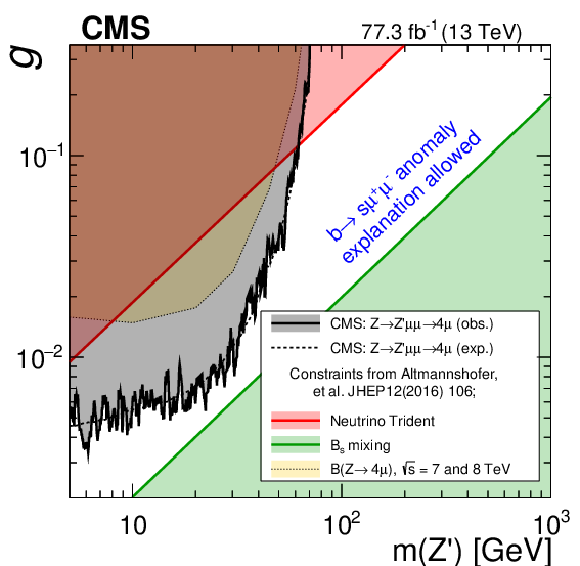
png pdf |
Figure 6-b:
Comparison with other experiments sensitive to the same parameter space, with shaded regions being excluded as described in the text. These three constraints are adapted from Ref. [13]. |
| Tables | |

png pdf |
Table 1:
The numbers of expected background and signal events and the numbers of observed candidate events after the full selection with 80 $ < {m_{4 {\mu}}} < $ 100 GeV. The signal and $ {{\mathrm {q}} {\overline {\mathrm {q}}}} / {\mathrm {g}} {\mathrm {g}} \to 4 {{\mu}}$ background rates are both estimated from simulation. The signal predictions are reported with systematic uncertainties only, while the background predictions are reported with statistical and systematic uncertainties, respectively. Also shown are the numbers of expected background and signal events and the numbers of observed candidate events in the relevant mass windows for three $m({\mathrm {Z}'})$ hypotheses. The values of the coupling strengths are chosen for the purpose of illustration. |
| Summary |
| A search for a Z' gauge boson resulting from an $L_{\mu}-L_{\tau}$ U(1) local gauge symmetry is presented, based on data from proton-proton collisions at $\sqrt{s} = $ 13 TeV corresponding to an integrated luminosity of 77.3 fb$^{-1}$ recorded in 2016 and 2017 by the CMS detector at the LHC. Events with four muons having an invariant mass near the mass of the standard model Z boson are selected, and the search sensitivity is optimized for the presence of $\mathrm{Z} \to \mathrm{Z'}\mu\mu\to4\mu$ decays. The search places strong constraints on theories that attempt to explain various experimental anomalies including the lack of a dark matter signal in direct-detection experiments, tension in the measurement of the anomalous magnetic moment of the muon, and reports of possible lepton flavor universality violation in B meson decays. The event yields are consistent with the standard model expectations. Upper limits of $ 10^{-8} $-$ 10^{-7} $ at 95% confidence level are set on the product of branching fractions $\mathcal{B}(\mathrm{Z} \to \mathrm{Z'}\mu\mu) \mathcal{B}(\mathrm{Z'}\to\mu\mu)$, depending on the Z' mass, which excludes a Z' boson coupling strength to muons above 0.004-0.3. These are the first dedicated limits on $L_{\mu}-L_{\tau}$ models at the LHC and result in a significant increase in the excluded model parameter space. |
| References | ||||
| 1 | S. L. Glashow | Partial-symmetries of weak interactions | NP 22 (1961) 579 | |
| 2 | S. Weinberg | A model of leptons | PRL 19 (1967) 1264 | |
| 3 | A. Salam | Weak and electromagnetic interactions | in Elementary particle physics: relativistic groups and analyticity, N. Svartholm, ed., Almquvist & Wiskell, 1968, Proceedings of the eighth Nobel symposium | |
| 4 | P. Langacker | The physics of heavy $ \mathrm{Z'} $ gauge bosons | Rev. Mod. Phys. 81 (2009) 1199 | 0801.1345 |
| 5 | A. Leike | The phenomenology of extra neutral gauge bosons | PR 317 (1999) 143 | hep-ph/9805494 |
| 6 | J. Hewett and T. Rizzo | Low-energy phenomenology of superstring-inspired E6 models | PR 183 (1989) 193 | |
| 7 | X.-G. He, G. C. Joshi, H. Lew, and R. R. Volkas | Simplest $ {Z}^{{\prime}} $ model | PRD 44 (1991) 2118 | |
| 8 | F. del Aguila, M. Chala, J. Santiago, and Y. Yamamoto | Collider limits on leptophilic interactions | JHEP 03 (2015) 59 | 1411.7394 |
| 9 | S. Baek, N. G. Deshpande, X.-G. He, and P. Ko | Muon anomalous g-2 and gauged $ {L}_{\mu}-{L}_{\tau} $ models | PRD 64 (2001) 055006 | hep-ph/0104141 |
| 10 | W. Altmannshofer, S. Gori, M. Pospelov, and I. Yavin | Quark flavor transitions in $ {L}_{{\mu}} {-}{L}_{{\tau}} $ models | PRD 89 (2014) 095033 | 1403.1269 |
| 11 | K. Harigaya et al. | Muon g-2 and LHC phenomenology in the L$ _{\mu} $ - L$ _{\tau} $ gauge symmetric model | JHEP 03 (2014) 105 | 1311.0870 |
| 12 | N. F. Bell, Y. Cai, R. K. Leane, and A. D. Medina | Leptophilic dark matter with $ {Z}^{{'}} $ interactions | PRD 90 (2014) 035027 | 1407.3001 |
| 13 | W. Altmannshofer, S. Gori, S. Profumo, and F. S. Queiroz | Explaining dark matter and B decay anomalies with an L$ _{\mu}- $L$ _{\tau} $ model | JHEP 12 (2016) 106 | 1609.04026 |
| 14 | F. Elahi and A. Martin | Constraints on $ L_{\mu}-L_{\tau} $ interactions at the LHC and beyond | PRD 93 (2016) 015022 | 1511.04107 |
| 15 | F. Elahi and A. Martin | Using the modified matrix element method to constrain $ {L}_{{\mu}} {-}{L}_{{\tau}} $ interactions | PRD 96 (2017) 015021 | 1705.02563 |
| 16 | Muon g-2 Collaboration | Final report of the E821 muon anomalous magnetic moment measurement at BNL | PRD 73 (2006) 072003 | hep-ex/0602035 |
| 17 | LHCb Collaboration | Measurement of form-factor-independent observables in the decay $ B^{0} \to K^{*0} \mu^+ \mu^- $ | PRL 111 (2013) 191801 | 1308.1707 |
| 18 | LHCb Collaboration | Test of lepton universality using $ B^{+}\rightarrow K^{+}\ell^{+}\ell^{-} $ decays | PRL 113 (2014) 151601 | 1406.6482 |
| 19 | F. A. Berends, R. Pittau, and R. Kleiss | All electroweak four fermion processes in electron - positron collisions | NPB 424 (1994) 308 | hep-ph/9404313 |
| 20 | CMS Collaboration | Observation of Z decays to four leptons with the CMS detector at the LHC | JHEP 12 (2012) 034 | CMS-SMP-12-009 1210.3844 |
| 21 | ATLAS Collaboration | Measurements of Four-Lepton Production at the Z Resonance in pp Collisions at $ \sqrt s= $ 7 and 8 TeV with ATLAS | PRL 112 (2014) 231806 | 1403.5657 |
| 22 | CMS Collaboration | Measurements of the pp$ \rightarrow $ZZ production cross section and the Z$ \rightarrow4\ell $ branching fraction, and constraints on anomalous triple gauge couplings at $ \sqrt{s}= $ 13 TeV | Eur. Phys. J C 78 (2018) 165 | CMS-SMP-16-017 1709.08601 |
| 23 | CMS Collaboration | The CMS experiment at the CERN LHC | JINST 3 (2008) S08004 | CMS-00-001 |
| 24 | CMS Collaboration | Description and performance of track and primary-vertex reconstruction with the CMS tracker | JINST 9 (2014) P10009 | CMS-TRK-11-001 1405.6569 |
| 25 | CMS Collaboration | The CMS trigger system | JINST 12 (2017) P01020 | CMS-TRG-12-001 1609.02366 |
| 26 | CMS Collaboration | Measurement of the inclusive W and Z production cross sections in pp collisions at $ \sqrt{s}= $ 7 TeV | JHEP 10 (2011) 132 | CMS-EWK-10-005 1107.4789 |
| 27 | J. Alwall et al. | The automated computation of tree-level and next-to-leading order differential cross sections, and their matching to parton shower simulations | JHEP 07 (2014) 79 | 1405.0301 |
| 28 | P. Nason | A new method for combining NLO QCD with shower Monte Carlo algorithms | JHEP 11 (2004) 040 | hep-ph/0409146 |
| 29 | S. Frixione, P. Nason, and C. Oleari | Matching NLO QCD computations with parton shower simulations: the POWHEG method | JHEP 11 (2007) 070 | 0709.2092 |
| 30 | S. Alioli, P. Nason, C. Oleari, and E. Re | A general framework for implementing NLO calculations in shower Monte Carlo programs: the POWHEG BOX | JHEP 06 (2010) 043 | 1002.2581 |
| 31 | J. M. Campbell and R. K. Ellis | MCFM for the Tevatron and the LHC | NPPS 205-206 (2010) 10 | 1007.3492 |
| 32 | R. D. Ball et al. | Unbiased global determination of parton distributions and their uncertainties at NNLO and at LO | NPB 855 (2012) 153 | 1107.2652 |
| 33 | M. Grazzini, S. Kallweit, and D. Rathlev | ZZ production at the LHC: fiducial cross sections and distributions in NNLO QCD | PLB 750 (2015) 407 | 1507.06257 |
| 34 | M. Bonvini et al. | Signal-background interference effects in $ gg \to H \to WW $ beyond leading order | PRD 88 (2013) 034032 | 1304.3053 |
| 35 | K. Melnikov and M. Dowling | Production of two Z-bosons in gluon fusion in the heavy top quark approximation | PLB 744 (2015) 43 | 1503.01274 |
| 36 | C. S. Li, H. T. Li, D. Y. Shao, and J. Wang | Soft gluon resummation in the signal-background interference process of $ gg(\to h^*) \to ZZ $~ | JHEP 08 (2015) 065 | 1504.02388 |
| 37 | G. Passarino | Higgs CAT | EPJC 74 (2014) 2866 | 1312.2397 |
| 38 | S. Catani and M. Grazzini | Next-to-next-to-leading-order subtraction formalism in hadron collisions and its application to Higgs-boson production at the Large Hadron Collider | PRL 98 (2007) 222002 | hep-ph/0703012 |
| 39 | M. Grazzini | NNLO predictions for the Higgs boson signal in the H $ \to $ WW $ \to\ell\nu\ell\nu $ and H$ \to $ ZZ $ \to4\ell $ decay channels | JHEP 02 (2008) 043 | 0801.3232 |
| 40 | M. Grazzini and H. Sargsyan | Heavy-quark mass effects in Higgs boson production at the LHC | JHEP 09 (2013) 129 | 1306.4581 |
| 41 | CMS Collaboration | Measurement of the properties of a Higgs boson in the four-lepton final state | PRD 89 (2014) 092007 | CMS-HIG-13-002 1312.5353 |
| 42 | CMS Collaboration | Measurement of differential and integrated fiducial cross sections for Higgs boson production in the four-lepton decay channel in pp collisions at $ \sqrt{s} = $ 7 and 8 TeV | JHEP 04 (2016) 005 | CMS-HIG-14-028 1512.08377 |
| 43 | CMS Collaboration | Measurements of properties of the Higgs boson decaying into the four-lepton final state in pp collisions at $ \sqrt{s}= $ 13 TeV | JHEP 11 (2017) 047 | CMS-HIG-16-041 1706.09936 |
| 44 | T. Sjostrand et al. | An introduction to PYTHIA 8.2 | CPC 191 (2015) 159 | 1410.3012 |
| 45 | CMS Collaboration | Event generator tunes obtained from underlying event and multiparton scattering measurements | EPJC 76 (2016) 155 | CMS-GEN-14-001 1512.00815 |
| 46 | GEANT4 Collaboration | GEANT4--A simulation toolkit | NIMA 506 (2003) 250 | |
| 47 | J. Allison et al. | GEANT4 developments and applications | IEEE Trans. Nucl. Sci. 53 (2006) 270 | |
| 48 | CMS Collaboration | Particle-flow reconstruction and global event description with the CMS detector | JINST 12 (2017), no. 10, P10003 | CMS-PRF-14-001 1706.04965 |
| 49 | CMS Collaboration | Performance of the CMS muon detector and muon reconstruction with proton-proton collisions at $ \sqrt{s}= $ 13 TeV | JINST 13 (2018) P06015 | CMS-MUO-16-001 1804.04528 |
| 50 | M. Cacciari, G. P. Salam, and G. Soyez | The anti-$ {k_{\mathrm{T}}} $ jet clustering algorithm | JHEP 04 (2008) 063 | 0802.1189 |
| 51 | M. Cacciari, G. P. Salam, and G. Soyez | FastJet user manual | EPJC 72 (2012) 1896 | 1111.6097 |
| 52 | R. Frühwirth | Application of Kalman filtering to track and vertex fitting | NIMA 262 (1987) 444 | |
| 53 | CMS Collaboration | Performance of CMS muon reconstruction in pp collision events at $ \sqrt{s} = $ 7 TeV | JINST 7 (2012) P10002 | CMS-MUO-10-004 1206.4071 |
| 54 | CMS Collaboration | CMS Luminosity Measurements for the 2016 Data Taking Period | CMS-PAS-LUM-17-001 | CMS-PAS-LUM-17-001 |
| 55 | CMS Collaboration | CMS luminosity measurement for the 2017 data-taking period at $ \sqrt{s}= $ 13 TeV | CMS-PAS-LUM-17-004 | CMS-PAS-LUM-17-004 |
| 56 | J. Butterworth et al. | PDF4LHC recommendations for LHC Run II | JPG 43 (2016) 023001 | 1510.03865 |
| 57 | T. Junk | Confidence level computation for combining searches with small statistics | NIMA 434 (1999) 435 | hep-ex/9902006 |
| 58 | A. L. Read | Presentation of search results: The CL$ _{\text{s}} $ technique | JPG 28 (2002) 2693 | |
| 59 | ATLAS, CMS, LHC Higgs Combination Group | Procedure for the LHC Higgs boson search combination in Summer 2011 | CMS-NOTE-2011-005 | |
| 60 | G. Cowan, K. Cranmer, E. Gross, and O. Vitells | Asymptotic formulae for likelihood-based tests of new physics | EPJC 71 (2011) 1554 | 1007.1727 |
| 61 | K. Melnikov and F. Petriello | The $ W $ boson production cross section at the LHC through $ O(\alpha^2_s) $ | PRL 96 (2006) 231803 | hep-ph/0603182 |
| 62 | R. Gavin, Y. Li, F. Petriello, and S. Quackenbush | FEWZ 2.0: A code for hadronic Z production at next-to-next-to-leading order | CPC 182 (2011) 2388 | 1011.3540 |
| 63 | R. Gavin, Y. Li, F. Petriello, and S. Quackenbush | W Physics at the LHC with FEWZ 2.1 | CPC 184 (2013) 208 | 1201.5896 |
| 64 | CCFR Collaboration | Neutrino tridents and W-Z interference | PRL 66 (1991) 3117 | |
| 65 | W. Altmannshofer, S. Gori, M. Pospelov, and I. Yavin | Neutrino Trident Production: A Powerful Probe of New Physics with Neutrino Beams | PRL 113 (2014) 091801 | 1406.2332 |

|
Compact Muon Solenoid LHC, CERN |

|

|

|

|

|

|